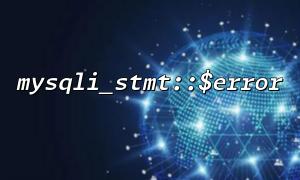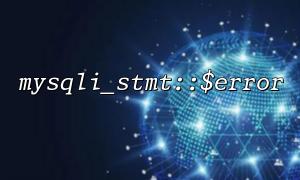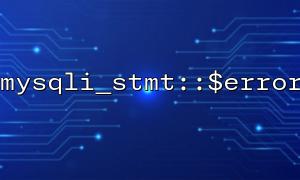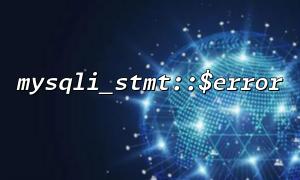SQL injection attacks have always been a security risk that cannot be ignored when developing web applications that use PHP for database interaction. To effectively defend against SQL injection, developers usually use prepared statements . However, even so, various difficulties may still be encountered when debugging preprocessing statements, especially when errors occur, and it is difficult to accurately locate the problem.
Fortunately, PHP's mysqli_stmt class provides the $error attribute, which can help developers better understand and diagnose SQL errors and improve the debugging capabilities of SQL injection defense. Next, we will explore how to improve debugging efficiency during development through mysqli_stmt::$error .
First, we briefly review how to use mysqli 's preprocessing statements to prevent SQL injection:
<?php
$mysqli = new mysqli("localhost", "username", "password", "database");
if ($mysqli->connect_error) {
die("Connection failed: " . $mysqli->connect_error);
}
$stmt = $mysqli->prepare("SELECT * FROM users WHERE username = ? AND password = ?");
$stmt->bind_param("ss", $username, $password);
$username = "admin";
$password = "password123";
$stmt->execute();
$stmt->close();
$mysqli->close();
?>
The above code uses preprocessing statements to prevent SQL injection attacks. Since the data entered by users (such as $username and $password ) will not be directly embedded in SQL queries, attackers cannot manipulate the database by entering malicious SQL code.
mysqli_stmt::$error is a property of the mysqli_stmt object, which is used to obtain error information for the recently executed SQL statement. Through this property, developers can obtain detailed error information about SQL query execution failure during debugging. Generally, when using preprocessing statements, if a query error occurs, you can quickly diagnose the problem by checking $stmt->error without exposing detailed database errors to the end user.
We can view the error information of the query before and after the SQL query is executed. For example:
<?php
$mysqli = new mysqli("localhost", "username", "password", "database");
if ($mysqli->connect_error) {
die("Connection failed: " . $mysqli->connect_error);
}
$stmt = $mysqli->prepare("SELECT * FROM users WHERE username = ? AND password = ?");
if ($stmt === false) {
die("Failed to prepare the query: " . $mysqli->error);
}
$stmt->bind_param("ss", $username, $password);
$username = "admin";
$password = "password123";
$stmt->execute();
if ($stmt->error) {
echo "SQL Error: " . $stmt->error;
} else {
echo "Query executed successfully.";
}
$stmt->close();
$mysqli->close();
?>
In this example, we checked $stmt->error after execution of $stmt->execute() and if there is an error, it will return a detailed error message. This approach can help developers discover and locate potential SQL problems during debugging, thereby optimizing queries or tuning code.
The core idea of SQL injection defense is to minimize direct execution of dynamic SQL queries and use preprocessing statements to avoid malicious input. But in actual development, we may encounter some unforeseen errors, or it is impossible to determine whether a query is executed correctly. In this case, the $error property can provide the following help:
Debugging SQL statements: When the SQL statement fails to execute, $stmt->error can provide detailed error information to help developers quickly locate problems.
Improve security: During the development stage, you can obtain valuable error information by viewing $stmt->error , but in production environments, avoid exposing this information directly to users. By using this property in debug mode, it is guaranteed that sensitive information will not be leaked while defending against SQL injection.
Optimized query: By checking for SQL errors, developers can optimize database queries to avoid unnecessary performance bottlenecks and potential injection vulnerabilities.
Although $stmt->error provides useful debugging information, it is not safe to expose error information in a production environment. Because error messages may contain sensitive database structures, table names, column names, etc., this information is very valuable to attackers. To ensure safety, the following measures can be taken in a production environment:
<?php
if ($stmt->error) {
// Record only errors,Avoid displaying to users
error_log("SQL Error: " . $stmt->error);
echo "An error occurred. Please try again later.";
} else {
echo "Query executed successfully.";
}
?>
In this example, the error message is logged into the log file, rather than being displayed directly to the user. This can effectively reduce potential security risks.
By combining the mysqli_stmt::$error attribute, PHP developers can more easily debug problems in preprocessing statements, helping to improve the effectiveness of SQL injection defense. Although the $error attribute itself does not directly prevent SQL injection, it provides valuable feedback to developers, allowing it to accurately optimize database queries and improve code quality while defending against injection attacks. In order to ensure the security of the system, developers must also handle error information carefully to avoid leaking too much debugging information in the production environment.
Related Tags:
mysqli_stmt SQL














